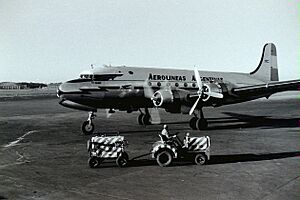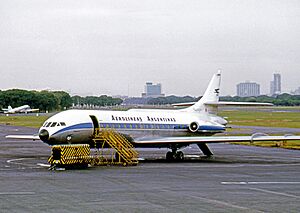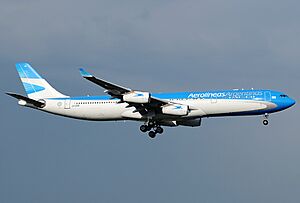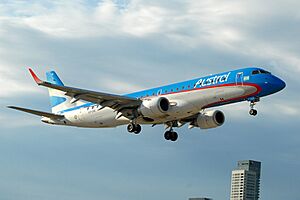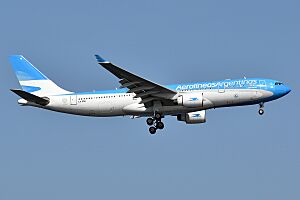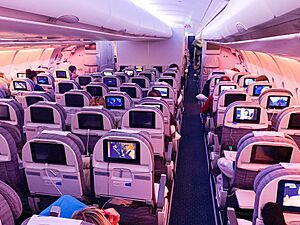Aerolíneas Argentinas facts for kids
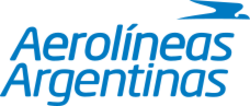
An Airbus A330-200 of Aerolíneas Argentinas
|
|
| Founded | 14 May 1949 |
|---|---|
| Commenced operations | 7 December 1950 |
| AOC # | AISF117C |
| Hubs |
|
| Focus cities |
|
| Frequent-flyer program | Aerolíneas Plus |
| Alliance | |
| Subsidiaries |
|
| Fleet size | 82 |
| Parent company | Government of Argentina |
| Headquarters | Aeroparque Jorge Newbery, Buenos Aires, Argentina |
| Key people | Fabian Lombardo (president & CEO) |
| Revenue | |
| Net income | |
| Total assets | |
| Total equity | |
| Employees | 10,230 (FY 2019) |
Aerolíneas Argentinas is Argentina's main airline and its largest. It is owned by the Government of Argentina. The airline started in 1949 when four smaller airlines joined together. It began flying in December 1950.
Over the years, Aerolíneas Argentinas changed ownership several times. A group led by Iberia took over in 1990. Later, Grupo Marsans bought the company in 2001. After facing big money problems, the airline was bought back by the Argentine government in 2008.
Aerolíneas Argentinas has its main offices in Buenos Aires. It joined the SkyTeam airline alliance in August 2012. Its cargo (freight) division, Aerolíneas Argentinas Cargo, joined SkyTeam Cargo in November 2013.
The airline flies from two main airports in Buenos Aires: Aeroparque Jorge Newbery and Ministro Pistarini International Airport. For shorter flights within Argentina and to nearby countries, it uses planes like the Embraer E190 and different models of the Boeing 737. For longer flights across oceans, it uses the larger Airbus A330-200.
Contents
History of Aerolíneas Argentinas
How the Airline Started
The story of Aerolíneas Argentinas began in 1929. A French company called Compagnie Générale Aéropostale started flying mail between Buenos Aires and other cities. Famous French pilots, like the author Antoine de Saint-Exupéry, flew for this company. Over time, Argentine pilots took over.
In 1947, one of Aéropostale's Argentine branches, Aeroposta Argentina, became a company partly owned by the government and partly by private investors. Three other similar companies were also flying in Argentina. Because these companies were not making enough money, the President of Argentina, Juan Perón, decided to combine them into one big airline. This happened on May 14, 1949. The new state-owned company was officially named Aerolíneas Argentinas. It started flying on its own on December 7, 1950.
Growing with New Planes
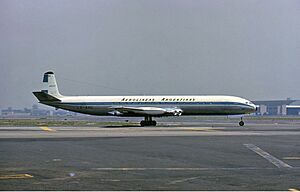
In 1950, Aerolíneas Argentinas quickly added new planes like the Convairs and Douglas DC-6. It started flying to cities like Rio de Janeiro, Paris, and Frankfurt. Soon after, it added flights to Santiago, Lima, and São Paulo. By 1953, the airline's network was very large, covering about 35,000 miles.
Aerolíneas Argentinas was a leader in South America. In 1959, it became the first airline outside of Europe to order the De Havilland Comet, which was a very modern jet plane at the time. The first Comet flew from England to Buenos Aires in just over 18 hours. Comet flights to New York City began in May 1959.
In the 1960s, the airline added more modern planes like the Avro 748 and the Sud Aviation Caravelle. By 1965, the airline had many employees and a diverse fleet of aircraft. In 1966, Aerolíneas Argentinas bought several Boeing 707-320B planes, which were important for long-distance flights.
By 1970, the airline's fleet included six Boeing 707s for flights to Europe and the United States, and other jets for regional and domestic routes. During the 1970s, more Boeing planes arrived, including the Boeing 727, Boeing 737, and the very large Boeing 747. In 1977, Frankfurt, Madrid, and Rome became the first cities served by the new 747s. In 1980, the airline made history with the first regular flight across the South Pole, connecting Buenos Aires with Hong Kong via Auckland.
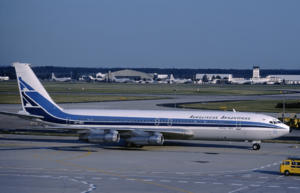
In 1971, a law gave Aerolíneas Argentinas the only right to operate international flights from Argentina. This made it the official national airline. It also got a large share of the domestic flight market.
In 1980, another airline, Austral, was also bought by the Argentine government. This led to some challenges, including a long strike by Aerolíneas Argentinas pilots in 1986. Other airlines took advantage of this situation.
During the Falklands War in 1982, the airline was not allowed to fly over British airspace. Flights to London had to stop in Madrid. By 1985, Aerolíneas Argentinas had many employees and a large fleet, flying to many cities around the world, including Los Angeles, Miami, New York, Paris, and Sydney.
Privatization: 1990 to 2008
In 1990, the Argentine government decided to sell Aerolíneas Argentinas to private companies. A group led by Iberia bought a large part of the airline. This sale was part of a bigger plan by the government to reduce its debt. Even though the airline was making money before the sale, it soon faced financial difficulties under private ownership.
Iberia later reduced its ownership in Aerolíneas Argentinas. Other companies, like American Airlines, also became involved. However, the airline continued to struggle financially, losing a lot of money. By 2001, Aerolíneas Argentinas was in a very serious crisis and had to ask for protection from its creditors. Many flights were stopped, and most of its planes were grounded.
In late 2001, the Grupo Marsans bought a large share of the airline. They promised to invest money to restart flights. The airline slowly recovered and even made a profit in 2003, which was its first profit in five years.
Renationalization: 2008 Onwards
In May 2008, the Argentine government announced plans to increase its ownership in Aerolíneas Argentinas. By July 2008, the government took back control of the airline, buying 99.4% of its shares. The remaining small part was owned by the employees. At this time, many of the airline's planes were not flying.
The Argentine Congress officially approved the government taking over Aerolíneas Argentinas and its subsidiary Austral in September 2008. There were some disagreements about how much the government should pay the previous owners.
In September 2011, the airline completed the process of reorganizing its finances. The government also announced a plan to reduce the airline's financial losses. This plan included looking at flights that were not making money and updating its fleet.
Between 2008 and 2013, the number of passengers carried by Aerolíneas Argentinas grew significantly. The airline's income also increased, and its losses decreased. The number of planes in its fleet grew, and the average age of its planes became much younger. By 2017, the airline was aiming for even more passengers and lower losses.
From 2008 to 2021, Aerolíneas Argentinas received over $8 billion USD in support from the Argentine government.
Future Plans for Privatization
After Javier Milei became president of Argentina in 2023, he announced his plan to privatize the airline again. His idea is to give shares of the airline to its workers and stop government support. Airline unions have expressed their disagreement with this plan. In December 2023, President Milei announced a special order to start the process of privatization and giving shares to employees. He also plans to allow more competition in the airline industry.
How Aerolíneas Argentinas Works
Ownership and Other Companies
As of December 2014, the government of Argentina fully owned Aerolíneas Argentinas. The airline has several other companies that work with it. These include Aerolíneas Argentinas Cargo (for freight), Austral Líneas Aéreas (a domestic airline), Aerohandling (for airport services), JetPaq S.A. (another cargo division), and Optar S.A. (a tourism company).
The airline and its related companies operate from two main airports in Buenos Aires. Aeroparque Jorge Newbery is used for domestic and regional flights, especially for smaller planes. Ministro Pistarini International Airport is mainly for international flights, though some regional and domestic flights also use it.
As of December 2019, the airline and its related companies had 10,230 employees.
In 2020, during the COVID-19 pandemic, Aerolíneas Argentinas and its Austral subsidiary merged. Austral's planes became part of Aerolíneas' fleet, and the Aerolíneas Argentinas brand continued.
Leaders of the Company
Pablo Ceriani was the president of the airline until 2023. Fabian Lombardo, who was previously the chief commercial officer, became the president in 2024.
Main Office
The main office of Aerolíneas Argentinas is located at Aeroparque Jorge Newbery in Buenos Aires.
Where Aerolíneas Argentinas Flies
Airline Partnerships
Aerolíneas Argentinas joined the SkyTeam alliance in August 2012. It was the first airline from South America and the second from Latin America to join this group. Being part of an alliance means the airline works with other airlines to offer more destinations and benefits to passengers. The airline's cargo division, Aerolíneas Argentinas Cargo, also joined SkyTeam Cargo in November 2013.
Aerolíneas Argentinas has agreements to share flights with these airlines:
- Aeroméxico
- Air Europa
- Air France
- Boliviana de Aviacion
- China Eastern Airlines
- Delta Air Lines
- El Al
- Gol Linhas Aéreas Inteligentes
- ITA Airways
- KLM
- Korean Air
- LATAM Airlines
- Saudia
Connecting Flights (Interline Agreements)
Aerolíneas Argentinas Fleet
Current Aircraft
As of January 2025, Aerolíneas Argentinas uses the following planes:
| Aircraft | In service | Orders | Passengers | Notes | ||
|---|---|---|---|---|---|---|
| C | Y | Total | ||||
| Airbus A330-200 | 10 | — | 24 | 248 | 272 | |
| Boeing 737-700 | 7 | — | 8 | 120 | 128 | |
| Boeing 737-800 | 28 | — | 8 | 162 | 170 | |
| Boeing 737 MAX 8 | 12 | — | 8 | 162 | 170 | |
| Embraer E190 | 24 | — | 8 | 88 | 96 | To be retired and replaced by Embraer E195-E2. |
| Embraer E195-E2 | — | 12 | TBA | To replace Embraer E190. | ||
| Cargo fleet | ||||||
| Boeing 737-800BCF | 2 | — | Cargo | Deliveries from 2023. | ||
| Total | 83 | 12 | ||||
Planes No Longer Used
Aerolíneas Argentinas has used many different types of planes in the past, including:
- Airbus A310-300
- Airbus A320-200
- Airbus A340-200
- Airbus A340-300
- Avro York
- Boeing 707-320B
- Boeing 707-320C
- Boeing 727-100
- Boeing 727-200
- Boeing 737-200
- Boeing 737-200 Advanced
- Boeing 737-200C
- Boeing 737-300F
- Boeing 737-500
- Boeing 747-200B
- Boeing 747-400
- Boeing 747SP
- Caravelle III
- Caravelle VI-N
- Caravelle VI-R
- Convair CV-240
- Comet 4
- Comet 4C
- Douglas C-47
- Douglas C-47A
- Douglas C-47B
- Douglas C-54A
- Douglas DC-3
- Douglas DC-4
- Douglas DC-6
- Fokker F28 Mk-1000
- Fokker F28 Mk-4000
- Hawker Siddeley 748
- Lockheed Constellation
- McDonnell Douglas MD-83
- McDonnell Douglas MD-88
- NAMC YS-11-100
- Short Sandringham
- Vickers Viking
Newer Planes for the Fleet
Aerolíneas Argentinas started updating its fleet in 2009. It began leasing and buying new Boeing 737-700 planes to replace older models. These new planes were the first ones the company had bought in 17 years. In 2009, the airline also looked into getting more Boeing 737-800 aircraft. The last flight of the older Boeing 737-200 was in November 2009.
By November 2012, the airline was thinking about buying new long-haul planes like the Airbus A350-900 or the Boeing 787-9. In 2013, they planned to add leased Airbus A330-200s for flights to cities like Bogotá, Cancún, Caracas, and Miami.
In April 2013, Aerolíneas Argentinas agreed to lease six Boeing 737-800s. In October of that year, they announced a deal to buy 20 more of these planes. They also signed an agreement with Airbus in November 2013 to buy four more Airbus A330-200 aircraft. The first Airbus A330-200 bought directly from Airbus was delivered in March 2015.
In November 2017, the airline's CEO said they were looking for new planes to replace their older Airbus A340s, possibly the Boeing 787 or Airbus A350. The goal was for these new planes to start flying by 2020. In November 2017, Aerolíneas Argentinas became the first airline in Latin America to receive a Boeing 737 MAX 8.
New Look for the Planes
In June 2010, Aerolíneas Argentinas changed its look to appear more modern. The new logo uses light blue and grey colors. The planes' paint scheme now includes the colors of the Argentine flag (light blue and white) along with grey. The subsidiary airline Austral also adopted this new design.
Safety Record
According to the Aviation Safety Network, Aerolíneas Argentinas has not had a fatal accident since 1970. The company is known as one of the safest airlines in the world.
More to Explore
- Transport in Argentina
See also
 In Spanish: Aerolíneas Argentinas para niños
In Spanish: Aerolíneas Argentinas para niños


